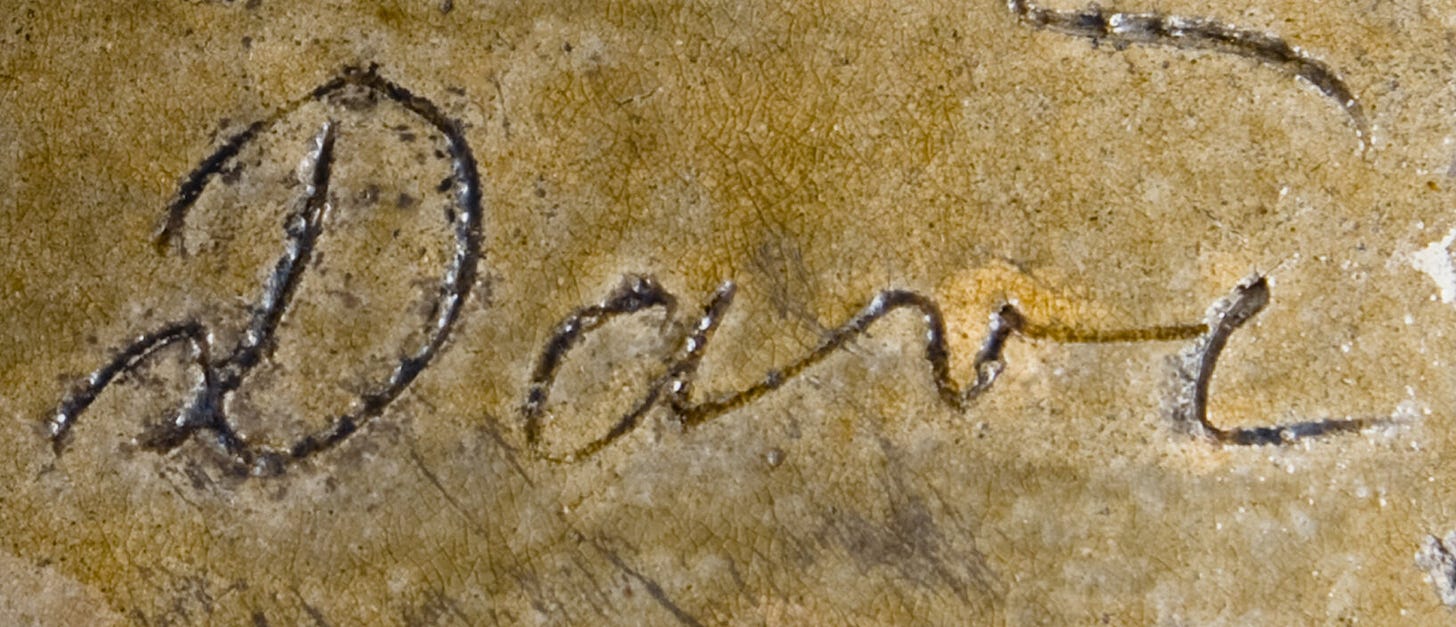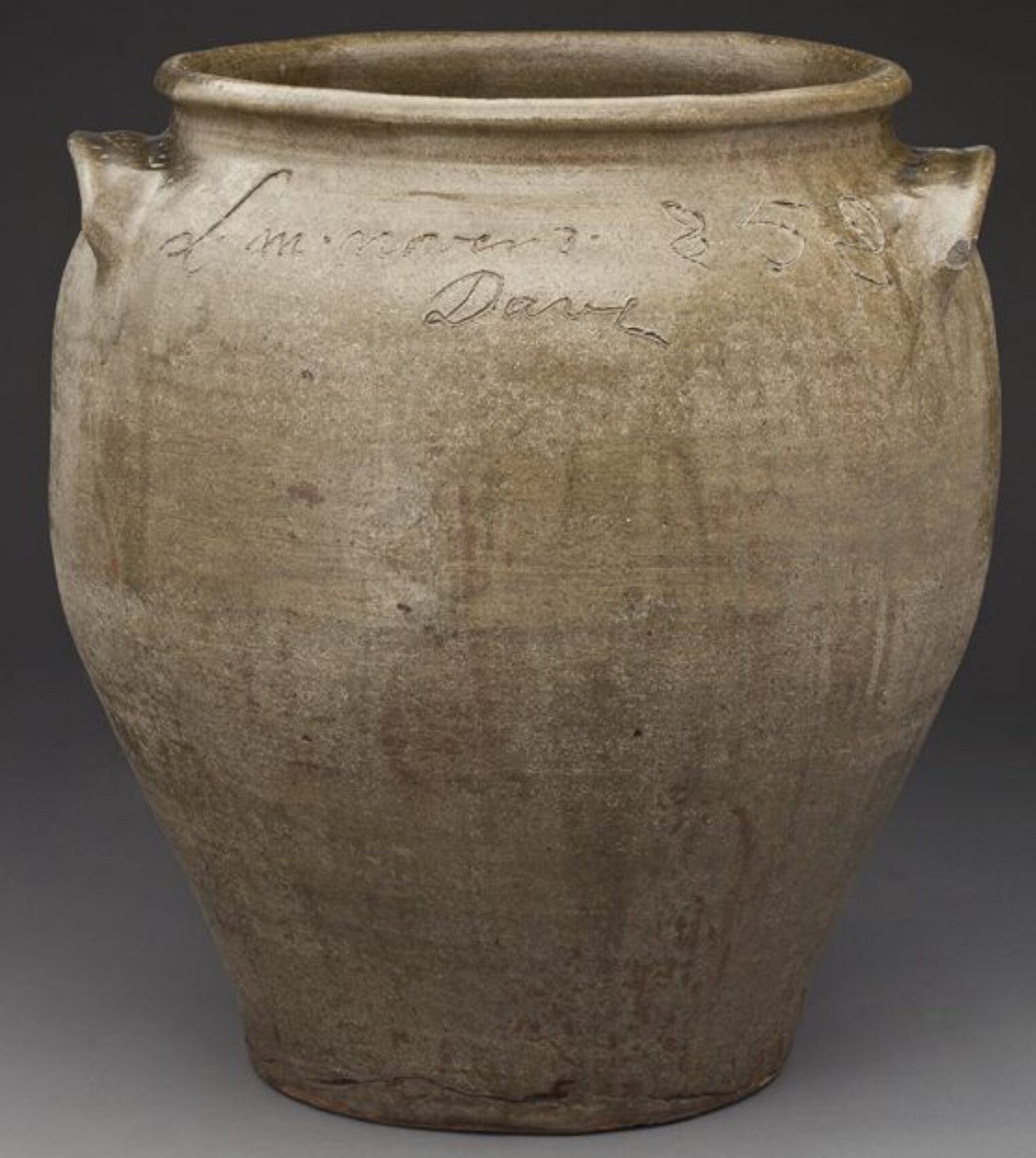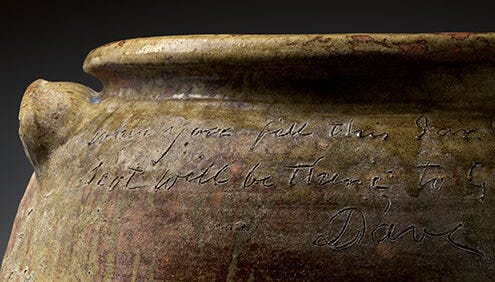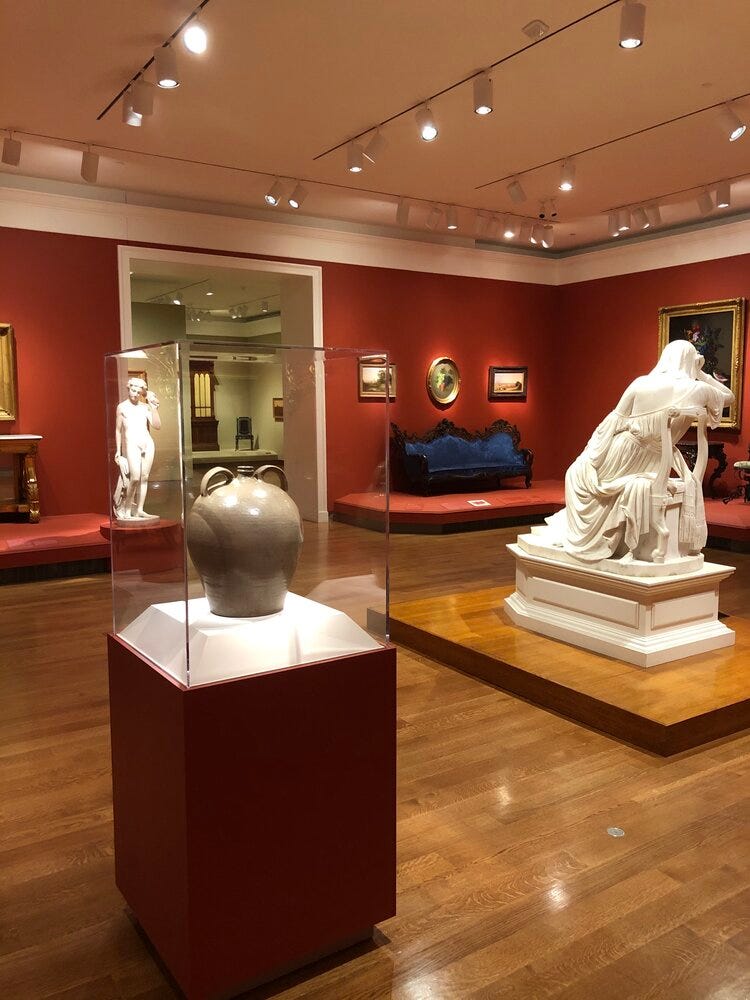David Drake’s Signature. Source: https://journalofantiques.com/features/pottery-south-carolinas-edgefield-district/
Potter David Drake is my hero. He’s often referred to as “Dave the Slave Potter”. He created impressive forty-five gallon jugs in Edgefield, SC while he was enslaved. It’s incredible that David Drake accomplished this feat with one leg in an era of foot wheels. He fashioned the vessels with the coil method and finished them on the kick wheel.
What makes David Drake so extraordinary among enslaved potters is the fact that David Drake was literate. He inscribed two-line poems and Biblical references along with the date and also his name on his work at a time when literacy was illegal for enslaved people. It’s often speculated that he lost his leg in connection to abuse for his written expression on his pottery: his voice that is now preserved in the clay.
When you see a David Drake vessel in a museum, the inscribed message reaches-out to you because of it’s three-dimensional imprint on the wood-fired surface. The clay preserves the immediacy of the script in the texture of the cut. These messages for us are combined with the tactile history of Drake’s fingerprints, texture of the local clay, and the gentle crazing of the glaze from the kiln process. Everything is on view in raw form, especially Dave’s power of voice. I suppose he may have used a porcupine quill or related tool to create the sharp cut into the leather-hard surface.
One side of the jar is inscribed “L.m. nover 3, 1858/ Dave.” The other is marked “I saw a leopard & a lions face/ then I felt the need – of grace,” an adaptation from the Book of Revelation. Source: https://mesda.org/exhibit/storage-jar/
Baltimore Potter David F. Mack is working to legislate some justice for the descendants of David Drake. Like me, he is a retired K-12 school teacher. He believes that Drake’s pottery works are his created wealth. His vessels now auction into private collections for incredible sums. Mack asserts that Drake’s wealth, like with property, should be returned to Drake’s family for them to do what they choose. Although he was never paid for his labor or skill (quite the opposite), Drake’s powerful works can be directly tied-back to him. This restorative justice would not apply to museums, only private collections. I think David F. Mack makes a strong argument. It ties into the question that many of us are considering in 2021: Does our wealth really belong to us if it originated through the institution of Slavery or Structural Racism? I often think on this question while at my wheel, in connection to the incredible collections that I admire so much in museums and in architectural history.
You can read more and see examples Drake’s work here:
Source: https://www.metmuseum.org/press/news/2020/the-met-acquires-rare-inscribed-vessel-by-david-drake
You can see David Drake’s important pottery jugs in the American Craft galleries at the Met, The Philadelphia Museum of Art, and the Art Museums of Colonial Williamsburg. The Smithsonian also has a piece, however it’s not on view. There are an estimated twenty surviving works with Drake’s poetry and signature in various collections. You can read more in Leonard Todd’s book on David Drake:
I took the opportunity to tour the tremendous Virginia Museum of Fine Arts in Richmond in January (VMFA). For fellow lovers of Art Nouveau and Art Deco decorative arts, the VMFA has one of the world’s top collections (and also five Faberge eggs).
Not surprising in the capital city of the Confederacy, there is also an impressive gallery of highly-refined art and decorative art from the Antebellum Period. The red satin room of French Second Empire Style treasures is effective in conveying the posh refinement found in plantation estates in the first half of the nineteenth century. The introduction plaque talks around the obvious elephant in the room: the enormous, relatively-crude syrup jug with a quirky inscription incised with a fast hand and signature: Dave.
The text description on the David Drake display case is honest about the institution of slavery. But, it’s only in the context of this folkware jug, not in the context of the entire room of refined Antebellum treasures. Once again, the Black man in the room is called-upon to explain slavery and racism because the White Establishment won’t or can’t within our own enlightened, posh salon. While the spray painted and empty pedestal of Stonewall Jackson stands nearby in 2021, it’s stunning that a treasure of American Folk Pottery (and also a significant artifact of the history of Voice in the African-American community) is displayed in context and also to explain Antebellum culture. It’s also left there to explain where the wealth came from.
I wrote a respectful, but pointed, email to the curatorial staff at the VMFA. As a folk potter, I suggested the David Drake jug be displayed in the context of folk craft (just as it is in other significant museum collections). It deserves to be considered for what it is, not to be used as a device to generate conversation in an already awkward gallery of alabaster-white nudes and gilded Empire furniture that work to validate Confederate sensibilities. I also suggested that it could be displayed in context with other African-American artwork if the value of the work is in Drake’s Voice as a literate slave. There is a long tradition of the power of Voice in African-American culture, and Drake’s signed jug could show that powerful arc of speaking out.
It’s now Black History Month, and I’ve yet to receive a reply from the curators at the Virginia Museum of Fine Art. Maybe I’ll reach-out to them again today.
If you’d like to comment, click on the title of this post and scroll down to the comment box. Thanks! -Mike
Update: February 19, 2021
I did reach-out, and I was contacted by the VMFA’s curator of American Art. We ended-up talking for several hours on the phone. It was tough talk, and I think we found a few points of agreement about how the Antebellum gallery can be improved from the visitor’s perspective (mostly the wording in the labels, red walls, and the inclusion of feedback from the community in the future plan for the room & collection). The curator pointed-out other pieces by African-Americans in the room as evidence that the gallery does not convey an overall impression of Wealth, Empire, and White European sensibilities. He bristled at my suggestion of the word “tokenism”. I encouraged him to look at my photos, and we see different things. We talked about our own implicit biases that color our impressions of the same view. This is important as the museum works to be more inclusive and welcoming to those who are not art historians. In hindsight, the conversation was right out of John Berger’s 1972 “Ways of Seeing” art book I read in a survey college class: https://en.wikipedia.org/wiki/Ways_of_Seeing
At the end of a long conversation, he stated that he is even-more certain that David Drake belongs in this room: the vessel is an accepted masterpiece of that era, and it belongs with other artistic treasures of the Antebellum time period and culture. If I understand correctly, he asserted there is no difference between Fine Art and Craft when it comes to curation of a region and period. If the museum’s future plan is to add more craft artifacts and class/culture diversity to make the period room more eclectic in the future redesign, I suggested the room be simply rebranded to make it more inclusive in scope: The American South 1800-1860. That went into a long talk about banjos, and if they would be included under this Southern parasol. It turned-out he wrote the book on that subject!
The VMFA purchased the David Drake vessel to diversify and to enhance their existing collection of Antebellum artwork in 2017. I repeatedly asked the curator how our appreciation of David Drake’s vessel is improved by being in this room as it exists today. I never received an answer, but we agreed this is a work in progress.
Update February 19, 2021. Dr. Leo Mazow’s reply to the blog post above:
I appreciate the heads-up, and in turn appreciate the time that you took to share your input with me. You are obviously free to write what you wish, and I am glad we were able to discuss some matters. A few points. I never said I see no difference between art and artifact; what I said is that I am not going to perpetuate artificial, long-debunked distinctions between "high" and "low" by isolating the work as you suggest, and which is quite different from what you are attributing to me. You also paraphrase me as saying, "the vessel is an accepted masterpiece of that era, and it belongs with other artistic treasures of the Antebellum time period and culture." That is misleading; I certainly did not use the words "antebellum" and "masterpiece" in this way. Re.your comment that I never answered your question, I specifically said that matters of literacy and industrialization-vs.-handmade are among those reasons that warrant its inclusion here.
But you are right about it being a work in progress. Diversity and inclusion in narrative and, equally importantly, who gets to tell that narrative in the first place, are matters of critical importance.
I want to post it to give him the opportunity to clarify in his own words. My reply:
Thank you for clarifying. I’m happy to post your reply for clarification. I think we both agree this conversation is important. Please remember we were talking specifically about the David Drake vessel in the Antebellum gallery at the VMFA, as it is today.
Although I’m intrigued by the potential that the Antebellum gallery will change to embrace this theme, I will add that “matters of literacy and industrialization-vs.-handmade” are not at all addressed in the gallery text today. The VMFA refers to Drake’s vessel as “an exceptional example of southern pottery” in their 2018 acquisition press release, I think we can agree with that statement.
Update February 22, 2021: Ceramist David F Mack Responds to my Fan Email on this Topic:
Thank you Mike for your support and advocacy to perpetuate a David Drake reparation movement. Your voice for change is exactly what I wanted our nation to understand about “stolen slave artifacts”. The wealth associated with trafficking stolen slave artifacts is astonishing, I will be presenting a virtual podcast during The 2021 NCECA Conference, 17 Mar, 2021, time tba...I hope you will watch. I have also just sent a letter to MD Congressman Mfume, to supporting introducing a resolution of our Turners Inheritance Act of 1619 to Congress. Most of Dave’s relations live in the MD, DC area. However, I am still looking for political support and assistance to get the reparations movement exposed to the people and our gov. Again, thank you for your support, and keep hope alive that one day justice will prevail.
Best Regards,
DM







